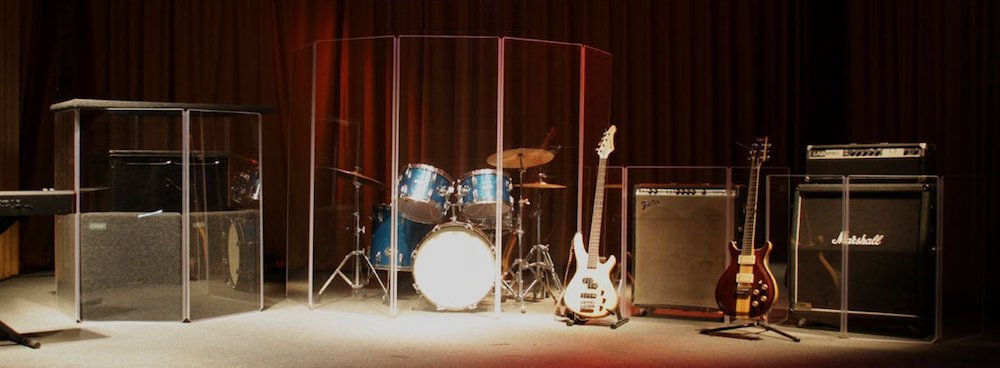by Brian Smith
It is no secret that many church music programs have been incorporating contemporary praise bands into some if not all of their services over the past several years. While the amplified guitars, bass, keyboards and drums help to add energy and excitement to a service and help draw the younger set into the church, many organizations find themselves fighting a new problem: over-powering sound levels with the acoustic drums seeming to be the lead culprit.
There are three main issues contributing to the problem: adverse room acoustics, insufficient acoustic separation, and insufficient isolation of the loud instruments.
Unfortunately, very few sanctuaries have acoustic properties conducive to loud instruments. Most rooms are designed with no regard for acoustic performance or with pianos and organs in mind, not percussion and amplified guitars.
If the acoustic decay, also know as reverb, time of the room is longer than three seconds, the sound in the room bounces around too long and "smears" the audio image, making it very difficult for the congregation to understand spoken word and song lyrics. In this case, the room should be treated with sound absorbing products to reduce the reverb time. If good acoustics was not a priority of your architect, you may have to install thousands of square feet of treatment at a cost of tens of thousands of dollars to fix the room. It seems that most architectural schools fail to stress the importance of good acoustics. Most architects seem more concerned with incorporating esthetically-pleasing hard materials like glass, wood, and tile into room designs than the detrimental effect that these materials have on room acoustics. While these materials may look great, they reflect almost all the sound that impacts them and so create the long reverb time. If you have not built yet, make sure that your architect places a premium on acoustic performance.
Even if you are lucky enough to have excellent room acoustics, if the drums are too loud, the other musicians can no longer hear their instruments so they do what you would expect: they turn it up louder!
The previously mentioned problems compound the third problem, obtaining sufficient acoustic separation between the vocals and the other instruments. Because the drums and most other musical instruments are so much louder than the vocals, some of the drum and instrument sound ends up “bleeding” into the vocal and choir mics. In this situation, if the person at the audio mixer attempts to bring up the vocals, a large amount of a very unpleasant and roomy-sounding drum and instrument bleed is also fed into the audio mix. This makes the mix coming out of your speakers very muddy and washes out the vocals. If only there were a way to bring the drums under control, you could get the other instruments to come back down to a reasonable level. If you have made the decision that something has to be done about excessive volumes, here are a couple ideas.
One option is to invest in an electronic drum set. Electric kits have the advantage of giving the sound engineer a lot of control over the drum levels. If you have tech-savvy drummers and sound personnel, an electronic drum kit can be a great solution. The disadvantages include having to dealing with a fairly complex system of wiring and programming and a less natural drum sound and feel that many drummers dislike. Good quality electronic drum kits like the mesh head Roland V-Drums start at around $3,800. Don’t waste your money on an inexpensive electronic kit unless you crave aggravation. Also note that while the pads are much quieter than drums, they still make clicking noises that you may find annoying in quiet passages.
If you decide that you would like to keep the sound and feel of a real drum kit, you may want to try out one of the new portable isolation enclosures now finding popularity in many churches. Some of the more popular systems are made ClearSonic Manufacturing. ClearSonic IsoPacs are portable isolation booths that combine ClearSonic Panel acrylic drum shields with SORBER absorption baffles and are available in a variety of configurations and sizes and start in the $1,500 range. The acrylic shields act as a see-through acoustic barrier while the 1.6-inch thick SORBER products are very efficient at soaking up sound. If you have a room with a long decay time, an IsoPac with a lid is highly recommended. While not completely sound tight, using an IsoPac or similar product will significantly reduce the amount of drum sound that will be leaked into the vocal and other instrument mics. This will allow the audio engineer to bring the vocals, choir or other quiet instruments up in the mix without introducing the unpleasant, roomy-sounding drum bleed described earlier. For most applications, just add a kick and overhead mic to bring a bit of controlled drum presence back into the PA mix.
Note that in most cases, it is not recommended to try to use only the reflective acrylic shield with no absorbing products. Because the sound would be reflected off the screen and again off the wall behind the drums with little reduction in energy, the much of the sound will still end up at the listener’s ear but after an added delay. This can make a bad situation worse by smearing the audio even more.
I hope that these tips will help you assemble the tools you need to put on a great sounding service at a reasonable volume level.
Brian Smith is the President of Clearsonic Manufacturing.
Take a look at all of the Clearsonic products that we feature on our website by clicking here.

